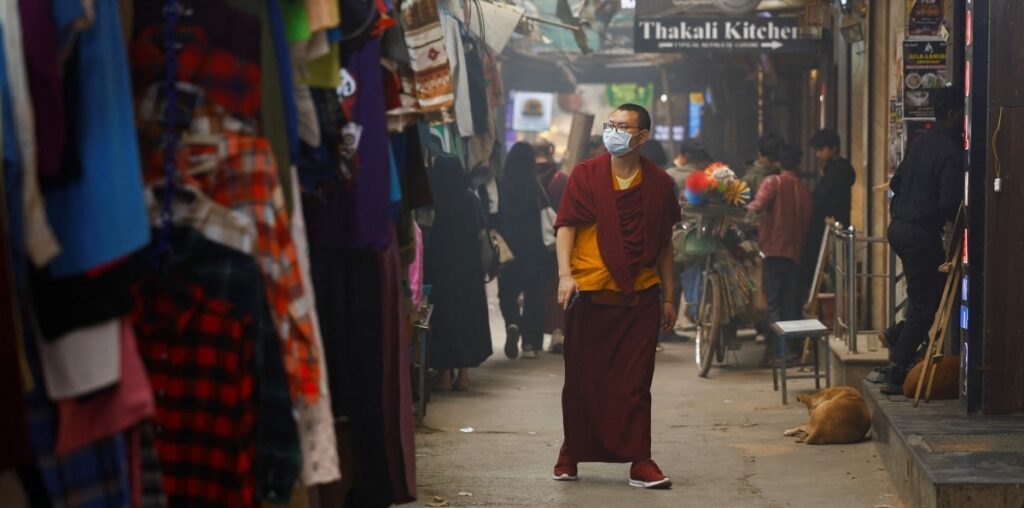Delhi’s air quality has been oscillating between ‘severe’ to ‘severe-plus’ categories for the past few days.
The crisis has led to an
increasing number of people seeking medical attention.
The
deteriorating air quality is not only affecting people with pre-existing health conditions but also healthy individuals.
There has also been a rise in cases of ‘walking pneumonia’. Here’s what it means.
What is walking pneumonia?
Walking pneumonia is a non-medical term for a mild case of pneumonia that results in swelling of the airways and accumulation of mucus in the lungs’ air sacs.
Often referred to as “silent” pneumonia, Mycoplasma pneumonia is the common bacterium that causes the condition.
It got its name in the 1930s because people are permitted to continue with their regular activities and no hospitalisation or prolonged bed rest was necessary.
However, severe pollution has exacerbated the symptoms among patients. According to a 2009 study, those who spent a year in high concentrations of nitrogen dioxide and fine particulate matter were twice as likely to get pneumonia.
Also read:
Was Delhi AQI’s 494 or 1600? The difference in pollution readings explained
How is it different from pneumonia?
In regular pneumonia, congestion affects a specific lobe or area of the lung.
Walking pneumonia spreads patchily and can become a full-fledged infection when environmental factors like pollution make it worse.
It mostly affects the youngest age group, which is between the ages of five and 14, while it can also happen to individuals under 40.
The virus is also more likely to infect people with asthma, chronic illnesses, weakened immune systems, and those taking steroids for certain medical conditions.
What are its symptoms?
The symptoms of walking pneumonia resemble those of the flu and include fever, chills, cough, headache, sore throat, weakness, and rash.
Additionally, a person with walking pneumonia experiences mild respiratory symptoms that persist for longer than the typical three to five days of an acute respiratory illness.
It is usually diagnosed by a physical exam or an X-ray.
How does it spread?
The condition spreads when an infected person breathes, talks, coughs or sneezes near others. This happens as the pathogen’s respiratory droplets float in the air.
In the case of a virus, the spread is faster. A carrier has a 10-day infectious period.
It usually spreads in busy places, such as colleges and schools.
Also read:
Delhi smog disrupts flights: Can CAT III technology help land planes in low visibility?
How is it treated?
If the infection is bacterial, a doctor may give antibiotics.
If it’s a virus, however, the infection resolves on its own and just symptomatic care is needed.
How can it be prevented?
Vaccinate yourself against the flu every year to help prevent flu-related pneumonia.
Consult a doctor about receiving a pneumonia vaccination. While there isn’t a vaccine to prevent viral or mycoplasma pneumonia, some people should have one to prevent pneumococcal pneumonia.
Get enough sleep, consume a healthy diet, and exercise.
Use warm, soapy water to wash your hands often and thoroughly.
Avoid smoking.
To help stop the spread of these viruses, cover your mouth when you cough or sneeze and encourage others to do the same.
How toxic is Delhi’s air?
It was yet another
polluted morning in Delhi as a light layer of smog and pollutants engulfed the National Capital, which is home to nearly seven crore people.
The Central Pollution Control Board (CPCB) reports that particulate matter 2.5 (PM2.5) is the predominant pollutant in Delhi’s air, which improved somewhat but remained in the “very poor” category with an overall air quality index (AQI) of 373.
An AQI between 0 and 50 is considered good, 51 and 100 satisfactory, 101 and 200 moderate, 201 and 300 poor, 301 and 400 very poor, 401 and 450 severe, and above 450 severe-plus.
Nine of the city’s 38 monitoring stations recorded AQI levels in the “severe” range. These stations were Anand Vihar, Bawana, Jahangirpuri, Mundka, Nehru Nagar, Shadipur, Sonia Vihar, Vivek Vihar, and Wazirpur.
As the city struggled with “very poor” air quality, despite the AQI dropping below the 400 mark after several days, the Centre enforced
staggered working hours for its Delhi employees on Thursday to help tackle pollution.
Authorities were also forced to switch schools to online classes and invoke strict pollution control measures like
GRAP Stage IV.
The Aam Aadmi Party (AAP) government is seeking to use
artificial rain to bring some relief from the noxious pollution. Delhi Environment Minister Gopal Rai on Tuesday wrote a letter to the Centre asking for its nod to allow artificial rain in the region.
Delhi and the neighbouring regions often top the air pollution ranks during the winter months.
This is because the
cold traps dust, pollutants, and smoke from farmers in nearby Punjab and Haryana burning their stubble illegally to make way for ploughing.
With inputs from agencies

